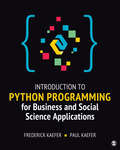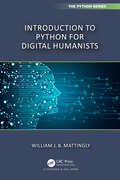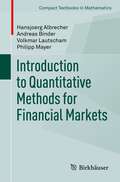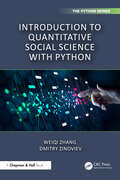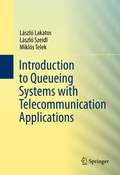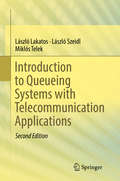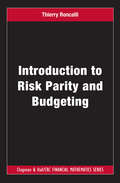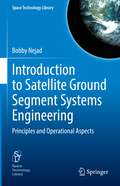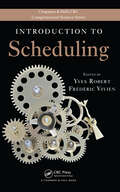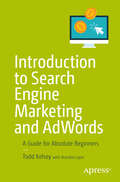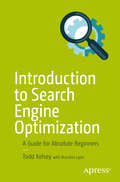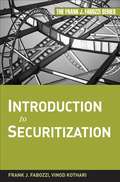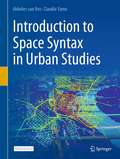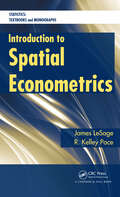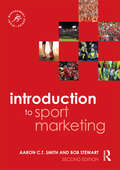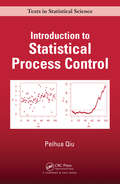- Table View
- List View
Introduction to Python Programming for Business and Social Science Applications
by Paul Kaefer Frederick KaeferWould you like to gather big datasets, analyze them, and visualize the results, all in one program? If this describes you, then Introduction to Python Programming for Business and Social Science Applications is the book for you. Authors Frederick Kaefer and Paul Kaefer walk you through each step of the Python package installation and analysis process, with frequent exercises throughout so you can immediately try out the functions you’ve learned. Written in straightforward language for those with no programming background, this book will teach you how to use Python for your research and data analysis. Instead of teaching you the principles and practices of programming as a whole, this application-oriented text focuses on only what you need to know to research and answer social science questions. The text features two types of examples, one set from the General Social Survey and one set from a large taxi trip dataset from a major metropolitan area, to help readers understand the possibilities of working with Python. Chapters on installing and working within a programming environment, basic skills, and necessary commands will get you up and running quickly, while chapters on programming logic, data input and output, and data frames help you establish the basic framework for conducting analyses. Further chapters on web scraping, statistical analysis, machine learning, and data visualization help you apply your skills to your research. More advanced information on developing graphical user interfaces (GUIs) help you create functional data products using Python to inform general users of data who don’t work within Python. First there was IBM® SPSS®, then there was R, and now there′s Python. Statistical software is getting more aggressive - let authors Frederick Kaefer and Paul Kaefer help you tame it with Introduction to Python Programming for Business and Social Science Applications.
Introduction to Python for Humanists (Chapman & Hall/CRC The Python Series)
by William MattinglyThis book will introduce digital humanists at all levels of education to Python. It provides background and guidance on learning the Python computer programming language, and as it presumes no knowledge on the part of the reader about computers or coding concepts allows the reader to gradually learn the more complex tasks that are currently popular in the field of digital humanities. This book will be aimed at undergraduates, graduates, and faculty who are interested in learning how to use Python as a tool within their workflow. An Introduction to Python for Digital Humanists will act as a primer for students who wish to use Python, allowing them to engage with more advanced textbooks. This book fills a real need, as it is first Python introduction to be aimed squarely at humanities students, as other books currently available do not approach Python from a humanities perspective. It will be designed so that those experienced in Python can teach from it, in addition to allowing those who are interested in being self-taught can use it for that purpose.Key Features: Data analysis Data science Computational humanities Digital humanities Python Natural language processing Social network analysis App development
Introduction to Quantitative Methods for Financial Markets
by Andreas Binder Hansjoerg Albrecher Volkmar Lautscham Philipp MayerSwaps, futures, options, structured instruments - a wide range of derivative products is traded in today's financial markets. Analyzing, pricing and managing such products often requires fairly sophisticated quantitative tools and methods. This book serves as an introduction to financial mathematics with special emphasis on aspects relevant in practice. In addition to numerous illustrative examples, algorithmic implementations are demonstrated using "Mathematica" and the software package "UnRisk" (available for both students and teachers). The content is organized in 15 chapters that can be treated as independent modules. In particular, the exposition is tailored for classroom use in a Bachelor or Master program course, as well as for practitioners who wish to further strengthen their quantitative background.
Introduction to Quantitative Social Science with Python (Chapman & Hall/CRC The Python Series)
by Weiqi Zhang Dmitry ZinovievDeparting from traditional methodologies of teaching data analysis, this book presents a dual-track learning experience, with both Executive and Technical Tracks, designed to accommodate readers with various learning goals or skill levels. Through integrated content, readers can explore fundamental concepts in data analysis while gaining hands-on experience with Python programming, ensuring a holistic understanding of theory and practical application in Python.Emphasizing the practical relevance of data analysis in today's world, the book equips readers with essential skills for success in the field. By advocating for the use of Python, an open-source and versatile programming language, we break down financial barriers and empower a diverse range of learners to access the tools they need to excel.Whether you're a novice seeking to grasp the foundational concepts of data analysis or a seasoned professional looking to enhance your programming skills, this book offers a comprehensive and accessible guide to mastering the art and science of data analysis in social science research.Key Features: Dual-track learning: Offers both Executive and Technical Tracks, catering to readers with varying levels of conceptual and technical proficiency in data analysis. Includes comprehensive quantitative methodologies for quantitative social science studies. Seamless integration: Interconnects key concepts between tracks, ensuring a smooth transition from theory to practical implementation for a comprehensive learning experience. Emphasis on Python: Focuses on Python programming language, leveraging its accessibility, versatility, and extensive online support to equip readers with valuable data analysis skills applicable across diverse domains.
Introduction to Queueing Systems with Telecommunication Applications
by Laszlo Lakatos Miklos Telek Laszlo SzeidlThe book is composed of two main parts: mathematical background and queueing systems with applications. The mathematical background is a self containing introduction to the stochastic processes of the later studies queueing systems. It starts with a quick introduction to probability theory and stochastic processes and continues with chapters on Markov chains and regenerative processes. More recent advances of queueing systems are based on phase type distributions, Markov arrival processes and quasy birth death processes, which are introduced in the last chapter of the first part. The second part is devoted to queueing models and their applications. After the introduction of the basic Markovian (from M/M/1 to M/M/1//N) and non-Markovian (M/G/1, G/M/1) queueing systems, a chapter presents the analysis of queues with phase type distributions, Markov arrival processes (from PH/M/1 to MAP/PH/1/K). The next chapter presents the classical queueing network results and the rest of this part is devoted to the application examples. There are queueing models for bandwidth charing with different traffic classes, slotted multiplexers, ATM switches, media access protocols like Aloha and IEEE 802.11b, priority systems and retrial systems. An appendix supplements the technical content with Laplace and z transformation rules, Bessel functions and a list of notations. The book contains examples and exercises throughout and could be used for graduate students in engineering, mathematics and sciences.
Introduction to Queueing Systems with Telecommunication Applications
by László Lakatos László Szeidl Miklós TelekThe book is the extended and revised version of the 1st edition and is composed of two main parts: mathematical background and queueing systems with applications. The mathematical background is a self-containing introduction to the stochastic processes of the later studied queueing systems. It starts with a quick introduction to probability theory and stochastic processes and continues with chapters on Markov chains and regenerative processes. More recent advances of queueing systems are based on phase type distributions, Markov arrival processes and quasy birth death processes, which are introduced in the last chapter of the first part.The second part is devoted to queueing models and their applications. After the introduction of the basic Markovian (from M/M/1 to M/M/1//N) and non-Markovian (M/G/1, G/M/1) queueing systems, a chapter presents the analysis of queues with phase type distributions, Markov arrival processes (from PH/M/1 to MAP/PH/1/K). The next chapter presents the classical queueing network results and the rest of this part is devoted to the application examples. There are queueing models for bandwidth charing with different traffic classes, slotted multiplexers, media access protocols like Aloha and IEEE 802.11b, priority systems and retrial systems.An appendix supplements the technical content with Laplace and z transformation rules, Bessel functions and a list of notations. The book contains examples and exercises throughout and could be used for graduate students in engineering, mathematics and sciences.Reviews of first edition:"The organization of the book is such that queueing models are viewed as special cases of more general stochastic processes, such as birth-death or semi-Markov processes. … this book is a valuable addition to the queuing literature and provides instructors with a viable alternative for a textbook to be used in a one- or two-semester course on queueing models, at the upper undergraduate or beginning graduate levels."Charles Knessl, SIAM Review, Vol. 56 (1), March, 2014
Introduction to Real Estate Development and Finance
by Richard M. LevyThis book provides readers with a basic understanding of the principles that underlie real estate development. A brief historical overview and an introduction to basic principles are followed by examples from practice. Case studies focus on how cities change and respond to the economic, technological, social, and political forces that shape urban development in North America. It is important to have a framework for understanding the risks and rewards in real estate investing. In measuring return, consideration must be given to both investment appreciation and the cash flow generated over the life of a project. In addition, metrics are presented that can be useful in assessing the financial feasibility of a real estate development proposal. This book also provides an overview of the forces of supply and demand that gauge the potential market for a new project. In determining the size of “residual demand”, estimates for population growth, family formation, and new development are important. All development projects fall under the auspices of one or several jurisdictions. Though every jurisdiction has different rules and procedures, basic knowledge of the planning process is critical to the success of all development projects regardless of location. Furthermore, all projects have a legal component. Basic issues of land ownership, property rights, property transfer, and land registration are reviewed, all of which need to be considered when a property is sold or purchased. This book also provides a primary on the design and construction process. In constructing a building, a team of experts is first required to design the architectural, structural, and heating, ventilation, and air conditioning (HVAC) systems for a building. An overview is provided of each building system: wood, concrete, and steel. Critical to a successful real estate development, project management principles for the processes of design, bidding, and construction are explored, with close attention given to budgeting, scheduling, and resource management. Essential reading for anyone involved in the development of our built environment, this is a must-read introduction for students and professionals in architecture, urban planning, engineering or real estate seeking an approachable and broad view of real estate development and finance.
Introduction to Responsibility Accounting Systems
by Jacob Cohen David F. HawkinsIntroduces responsibility accounting systems.
Introduction to Risk Parity and Budgeting (Chapman and Hall/CRC Financial Mathematics Series)
by Thierry RoncalliAlthough portfolio management didn't change much during the 40 years after the seminal works of Markowitz and Sharpe, the development of risk budgeting techniques marked an important milestone in the deepening of the relationship between risk and asset management. Risk parity then became a popular financial model of investment after the global fina
Introduction to Satellite Ground Segment Systems Engineering: Principles and Operational Aspects (Space Technology Library #41)
by Bobby NejadThe ground segment is the fundamental backbone of every satellite project, yet it is usually not visible to the public or the end user of a satellite service. Also the bulk of existing published space literature tends to focus on the satellite or its subsystems. This book tries to fill this gap and addresses systems engineering concepts applied to the design, development, qualification, and deployment of the ground control segment required to operate a single satellite, a constellation, or even a manned space vehicle. The domain of ground segment engineering has significantly evolved in recent years, mainly driven by major advances in the IT sector. Hardware virtualisation or the availability of on-demand cloud computing services are typical examples of new technologies that have changed fundamental architectural concepts previously standard in heritage ground segments. Furthermore, the stark increase of cyber attacks - today a major risk to almost all critical IT based infrastructure - has made a cyber threat resilient architecture to become one of the indispensable design requirements for ground segment engineers. The new mega constellations recently put into space deploying up to several hundred of flying objects have put very demanding needs on the ground segment for automated satellite operations. These topics and more are addressed in the book’s chapters, along with a detailed explanation of the most relevant components of a typical ground segment architecture. The basic functional requirements, design features, and the most important ground and space segment interfaces are addressed and explained in detail, supported by a wealth of figures for easier understanding. This book is kept at an introductory level, allowing newcomers to get familiar with this fairly complex subject matter. It is therefore suitable for graduate students, but can equally serve as a valuable source of information for already experienced space engineers who seek to gain a deeper understanding of the ground segment infrastructure and related systems engineering processes. It can also help project managers to better interact with their systems engineers, satellite developers to define their ground segment interfaces, and satellite operators to improve their flight and ground procedures. It is very well suited for everyone intending to start a career in satellite ground segment systems engineering.
Introduction to Scheduling (Chapman & Hall/CRC Computational Science)
by Yves Robert Frédéric VivienFull of practical examples, Introduction to Scheduling presents the basic concepts and methods, fundamental results, and recent developments of scheduling theory. With contributions from highly respected experts, it provides self-contained, easy-to-follow, yet rigorous presentations of the material.The book first classifies scheduling problems and
Introduction to Search Engine Marketing and AdWords: A Guide For Absolute Beginners
by Todd KelseyUse Google's AdWords to create your ads. Each chapter goes beyond the tool itself, discussing helpful resources and important issues to keep in mind. If you are completely new to search engine marketing and AdWords and you want to learn the basics, this guide will introduce you to the content quickly. Introduction to Search Engine Marketing and AdWords is not in-depth, comprehensive, or trying to cover every tool or platform--an impossible task! But it is an easy-to-understand introduction to the most important tools and skills in search engine marketing. What You'll Learn Take a behind-the-scenes tour of AdWords, including how to create an account Create and launch a campaign as well as ads, including keyword tools Monitor a campaign, including time frame, clicks and CTR, and reporting Implement various campaign strategies, including support email and dealing with errors Use Ad extensions as well as site links Who This Book Is For Those who need to get up to speed on search engine marketing tools and techniques for business or personal use. This book is also suitable as a student reference.
Introduction to Search Engine Optimization: A Guide For Absolute Beginners
by Todd KelseyDon't be intimidated by all the search engine optimization (SEO) tools out there. You will start out learning about keywords and the importance of quality content and then walk through incremental steps as you try out the tools and master the tips and strategies. If you are completely new to search engine optimization and you want to learn the basics, this guide will introduce you to the content quickly. Introduction to Search Engine Optimization is a detailed guide to the most important tools and skills needed to accurately and effectively utilize search engine optimization. This book covers SEO basics, keyword research, SEO ranking and analytics, Google Analytics, and more. It also includes an overview of how to pursue SEO-related certifications. What You'll Learn Create a content platform, including blogs and YouTube channels Use keywords to maximize findability and increase search volume Check your SEO rank and other analytics Hunt for duplicate content Set up Google Analytics, including Blogger Utilize Indexing and Webmaster tools/search console Who This Book Is For Those who need to get up to speed on search engine optimization tools and techniques for business or personal use. This book is also suitable as a student reference.
Introduction to Securitization
by Frank J. Fabozzi Vinod KothariIntroduction to Securitization outlines the basics of securitization, addressing applications for this technology to mortgages, collateralized debt obligations, future flows, credit cards, and auto loans. The authors present a comprehensive overview of the topic based on the experience they have gathered through years of interaction with practitioners and graduate students around the world. The authors offer coverage of such key topics as: structuring agency MBS deals and nonagency deals, credit enhancements and sizing, using interest rate derivatives in securitization transactions, asset classes securitized, operational risk factors, implications for financial markets, and applying securitization technology to CDOs. Finally, in the appendices, the authors provide an essential introduction to credit derivatives, an explanation of the methodology for the valuation of MBS/ABS, and the estimation of interest rate risk.Securitization is a financial technique that pools assets together and, in effect, turns them into a tradable security. The end result of a securitization transaction is that a corporation can obtain proceeds by selling assets and not borrowing funds. In real life, many securitization structures are quite complex and enigmatic for practitioners, investors, and finance students. Typically, books detailing this topic are either too lengthy, too technical, or too superficial in their presentation. Introduction to Securitization is the first to offer essential information on this topic at a fundamental, yet comprehensive level-providing readers with a working understanding of what has become one of today's most important areas of finance.Authors Frank Fabozzi and Vinod Kothari, internationally recognized experts in the field, clearly define securitization, contrast it with corporate finance, and explain its advantages. They carefully illustrate the structuring of asset-backed securities (ABS) transactions, including agency mortgage-backed securities (MBS) deals and nonagency deals, and show the use of credit enhancements and interest rate derivatives in such transactions. They review the collateral classes in ABS, such as retail loans, credit cards, and future flows, and discuss ongoing funding vehicles such as asset-backed commercial paper conduits and other structured vehicles. And they explain the different types of collateralized debt obligations (CDOs) and structured credit, detailing their structuring and analysis. To complement the discussion, an introduction to credit derivatives is also provided.The authors conclude with a close look at securitization's impact on the financial markets and the economy, with a review of the now well-documented problems of the securitization of one asset class: subprime mortgages. While questions about the contribution of securitization have been tainted by the subprime mortgage crisis, it remains an important process for corporations, municipalities, and government entities seeking funding. The significance of this financial innovation is that it has been an important form of raising capital for corporations and government entities throughout the world, as well as a vehicle for risk management. Introduction to Securitization offers practitioners and students a simple and comprehensive entry into the interesting world of securitization and structured credit.
Introduction to Smart eHealth and eCare Technologies (Devices, Circuits, and Systems #63)
by Sari Merilampi Andrew SirkkaBoth the demographics and lack of resources in the health and well-being industry are increasingly forcing us to find alternative solutions for individualized health and social care. In an effort to address this issue, smart technologies present enormous potential in solving this challenge. This book strives to enhance communication and collaboration between technology and health and social care sectors. The reader will receive an extensive overview of the possibilities of various technologies in care sectors (including ICT, electronics, automation, and sensor technology) written by experts from various countries. <P><P>It will prove extremely useful for engineers developing well-being related systems, software, or other devices that can be used by professionals working with people with specialist needs, well-being and health service providers, educators teaching related courses, and upper level undergraduate students and graduate student studying related topics. The technology focus of the book is widespread and addresses elderly care and hospitals, in addition to solutions for various user groups, devices, and technologies. Beyond serving as a resource for nurses and people working in care sector, the book is also meant to give guidelines for engineers developing person-centered systems by exploring the integration of these technologies into service systems.
Introduction to Social Housing
by Paul ReevesThe provision and management of social housing for those who are unable to access the housing market is essential to the maintenance of the fabric of society. The social housing industry is vast and still growing. There are very few countries in the world where some form of subsidised housing does not exist, and the total number of social homes is likely to grow worldwide, as are the challenges of the sector.Paul Reeves takes a people-centred approach to the subject, describing the themes that have run through provision of social housing from the first philanthropic industrialists in the 19th Century though to the increasingly complex mixture of ownerships and tenures in the present day. The management of housing forms a key part of the book, with an emphasis on the practical aspects of tenant participation and multi-agency working.The book is ideal for students of housing and social policy, and for housing professionals aiming to obtain qualifications and wanting a broad understanding of the social housing sector.
Introduction to Social Media Marketing: A Guide For Absolute Beginners
by Todd KelseyEasily understand the most important tools and skills in social media marketing. You'll be exposed to Facebook pages and ads, work with Twitter and LinkedIn, save time with Hootsuite, and learn social media monitoring. If you are completely new to social media marketing and you want to learn the basics, this guide will introduce you to the content quickly. Introduction to Social Media Marketing has a particular focus on ROI (return on investment), to help you think critically about the value social media could bring a business or organization. You'll explore the question of whether or not it's worth it to invest time and money in each social media channel. What You'll Learn Understand basic functions for most social media tools, including how to get up and running See the benefits of social media tools and which one you should use for specific purposes Calculate the real ROI expected from using specific tools Utilize social media monitoring and analytics Who This Book Is For Those who need to get up to speed on a broad range of social media tools and techniques for business or personal use. This book is also suitable as a student reference.
Introduction to Software Project Management
by Adolfo VillafioritaAlthough software development is one of the most complex activities carried out by man, sound development processes and proper project management can help ensure your software projects are delivered on time and under budget. Providing the know-how to manage software projects effectively, Introduction to Software Project Management supplies an acces
Introduction to Space Syntax in Urban Studies
by Claudia Yamu Akkelies van NesThis open access textbook is a comprehensive introduction to space syntax method and theory for graduate students and researchers. It provides a step-by-step approach for its application in urban planning and design. This textbook aims to increase the accessibility of the space syntax method for the first time to all graduate students and researchers who are dealing with the built environment, such as those in the field of architecture, urban design and planning, urban sociology, urban geography, archaeology, road engineering, and environmental psychology. Taking a didactical approach, the authors have structured each chapter to explain key concepts and show practical examples followed by underlying theory and provided exercises to facilitate learning in each chapter. The textbook gradually eases the reader into the fundamental concepts and leads them towards complex theories and applications. In summary, the general competencies gain after reading this book are:– to understand, explain, and discuss space syntax as a method and theory;– be capable of undertaking various space syntax analyses such as axial analysis, segment analysis, point depth analysis, or visibility analysis;– be able to apply space syntax for urban research and design practice;– be able to interpret and evaluate space syntax analysis results and embed these in a wider context;– be capable of producing new original work using space syntax.This holistic textbook functions as compulsory literature for spatial analysis courses where space syntax is part of the methods taught. Likewise, this space syntax book is useful for graduate students and researchers who want to do self-study. Furthermore, the book provides readers with the fundamental knowledge to understand and critically reflect on existing literature using space syntax.
Introduction to Spanish Private Law: Facing the Social and Economic Challenges (UT Austin Studies in Foreign and Transnational Law)
by Teresa Rodriguez de las Heras BallellThe topics addressed in this book have traditionally been covered in separate publications on civil and commercial law. This dualism of regimes has made it difficult for students and professionals alike to comprehend Spanish private law as a whole. In the past this has led to inefficient duplication of explanations, gaps in key areas and an altogether fragmented picture. Introduction to Spanish Private Law presents a consolidated, modern, and realistic image of today’s Spanish private legal system. It combines both civil and commercial law and integrates them in the same book, making the overall subject far more accessible to readers. This united approach results in a more logical and efficient process of learning. Finally the issues that are addressed reflect the reality of today’s economic and legal scene. This book attempts to provide the readers with the necessary legal instruments to tackle the real problems arising from a globalized modern society. The general principles in this book are presented from a practical point of view that emanates from the authors’ conception of a legal system as an instrument to solve social problems in accordance with a set of principles, values and aims.
Introduction to Spatial Econometrics (Statistics: A Series of Textbooks and Monographs)
by James LeSage Robert Kelley PaceAlthough interest in spatial regression models has surged in recent years, a comprehensive, up-to-date text on these approaches does not exist. Filling this void, Introduction to Spatial Econometrics presents a variety of regression methods used to analyze spatial data samples that violate the traditional assumption of independence between observat
Introduction to Sport Marketing: Second Edition (Sport Management Series)
by Constantino Stavros James Skinner Andrea N. Geurin Aaron C.T. Smith Lauren M. BurchNow in a fully revised and updated third edition, Introduction to Sport Marketing is a clear, straightforward, and concise introduction to the theory and practice of sport marketing, and the only sport marketing textbook you will ever need.Built around a step-by-step framework for developing effective sport marketing plans, and full of real-world, international cases, data, and examples, the text helps students to develop the essential skills and subject knowledge required to thrive in today’s fast-paced sport industry. It covers sport marketing at all levels, from grassroots and community sport to international mega-events, and across all sectors from professional sport to public and not-for-profit organisations. Leading the reader through the marketing process, from analysis and setting a strategy to planning the marketing mix, implementation, and evaluation, the text introduces the products, services, distribution channels, and stakeholders that generate value, including brands, merchandise and licensed products, players and athletes, leagues and franchises, and events. This new edition includes expanded coverage of cutting-edge topics, including social media, digital sport marketing, esports, the social impact of sport, ‘sportwashing’ and soft power, innovation and fast prototyping, consumer psychology, and diversity and equity. It includes useful features throughout, from review questions to guides to further resources.This is an essential textbook for any sport marketing course taken as a part of a degree programme in sport management, sport marketing, sport business, sport development, or business, management, and marketing.
Introduction to Sport Marketing: Second edition (Sport Management Series)
by Bob Stewart Aaron C.T. SmithIntroduction to Sport Marketing is an accessible and engaging introduction to key concepts and best practice in sport marketing. Aimed at students with little or no prior knowledge of marketing, the book outlines a step-by-step framework for effective sport marketing, from conducting market analysis and developing a strategy, through to detailed planning and implementation. The book has a wider scope than other sport marketing textbooks, recognising that students are just as likely to have to employ their marketing skills in community sport or the not-for-profit sector as in professional sport, and therefore represents the most realistic and useful sport marketing text currently available. Now in a fully revised and updated second edition, the book has expanded coverage of digital and social media, product innovation, services and relationship marketing, and key contemporary issues such as social responsibility and sustainability. It features a much wider range of international cases and examples, covering North America, Europe, and the vibrant and rapidly developing sport markets in Asia-Pacific, the Middle East and Latin America. Every chapter includes a range of useful features to help the reader to engage with fundamental principles and applied practice, such as problem-solving exercises and review questions. Introduction to Sport Marketing is an essential textbook for any degree-level sport marketing course.
Introduction to Statistical Methods for Financial Models (Chapman & Hall/CRC Texts in Statistical Science)
by Thomas A SeveriniThis book provides an introduction to the use of statistical concepts and methods to model and analyze financial data. The ten chapters of the book fall naturally into three sections. Chapters 1 to 3 cover some basic concepts of finance, focusing on the properties of returns on an asset. Chapters 4 through 6 cover aspects of portfolio theory and the methods of estimation needed to implement that theory. The remainder of the book, Chapters 7 through 10, discusses several models for financial data, along with the implications of those models for portfolio theory and for understanding the properties of return data. The audience for the book is students majoring in Statistics and Economics as well as in quantitative fields such as Mathematics and Engineering. Readers are assumed to have some background in statistical methods along with courses in multivariate calculus and linear algebra.
Introduction to Statistical Process Control (Chapman & Hall/CRC Texts in Statistical Science)
by Peihua QiuA major tool for quality control and management, statistical process control (SPC) monitors sequential processes, such as production lines and Internet traffic, to ensure that they work stably and satisfactorily. Along with covering traditional methods, Introduction to Statistical Process Control describes many recent SPC methods that improve upon
